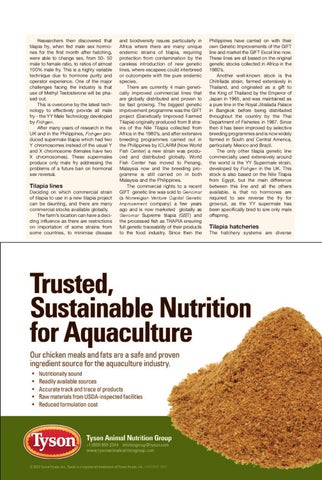Researchers then discovered that tilapia fry, when fed male sex hormones for the first month after hatching, were able to change sex, from 50- 50 male to female ratio, to ratios of almost 100% male fry. This is a highly variable technique due to hormone purity and operator experience. One of the major challenges facing the industry is that use of Methyl Testosterone will be phased out. This is overcome by the latest technology to effectively provide all male fry - the YY Male Technology developed by Fishgen. After many years of research in the UK and in the Philippines, Fishgen produced supermale tilapia which had two Y chromosomes instead of the usual Y and X chromosome (females have two X chromosomes). These supermales produce only male fry addressing the problems of a future ban on hormonal sex reversal.
Tilapia lines Deciding on which commercial strain of tilapia to use in a new tilapia project can be daunting, and there are many commercial stocks available globally. The farm’s location can have a deciding influence as there are restrictions on importation of some strains from some countries, to minimise disease
and biodiversity issues particularly in Africa where there are many unique endemic strains of tilapia, requiring protection from contamination by the careless introduction of new genetic lines, where escapees could interbreed or outcompete with the pure endemic species. There are currently 4 main genetically improved commercial lines that are globally distributed and proven to be fast growing. The biggest genetic improvement programme was the GIFT project (Genetically Improved Farmed Tilapia) originally produced from 8 strains of the Nile Tilapia collected from Africa in the 1980’s, and after extensive breeding programmes carried out in the Philippines by ICLARM (Now World Fish Center) a new strain was produced and distributed globally. World Fish Center has moved to Penang, Malaysia now and the breeding programme is still carried on in both Malaysia and the Philippines. The commercial rights to a recent GIFT genetic line was sold to Genomar (a Norweigian Venture Capital Genetic Improvement company) a few years ago and is now marketed globally as Genomar Supreme tilapia (GST) and the processed fish as TRAPIA ensuring full genetic traceability of their products to the food industry. Since then the
25
Philippines have carried on with their own Genetic Improvements of the GIFT line and market the GIFT Excel line now. These lines are all based on the original genetic stocks collected in Africa in the 1980’s. Another well-known stock is the Chitrilada strain, farmed extensively in Thailand, and originated as a gift to the King of Thailand by the Emperor of Japan in 1965, and was maintained as a pure line in the Royal Jitralada Palace in Bangkok before being distributed throughout the country by the Thai Department of Fisheries in 1967. Since then it has been improved by selective breeding programmes and is now widely farmed in South and Central America, particularly Mexico and Brazil. The only other tilapia genetic line commercially used extensively around the world is the YY Supermale strain, developed by Fishgen in the UK. This stock is also based on the Nile Tilapia from Egypt, but the main difference between this line and all the others available, is that no hormones are required to sex reverse the fry for growout, as the YY supermale has been specifically bred to sire only male offspring.
Tilapia hatcheries The hatchery systems are diverse
